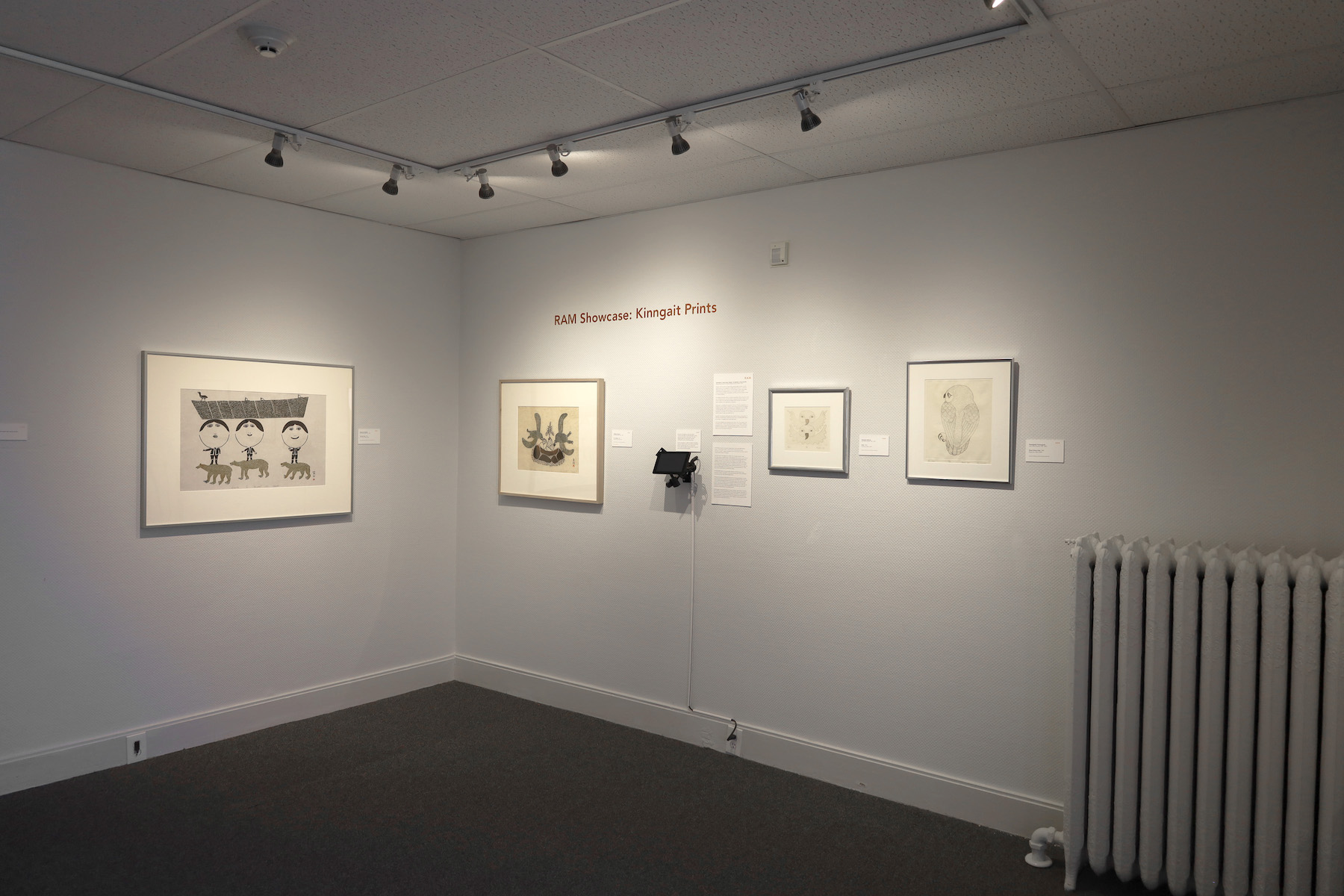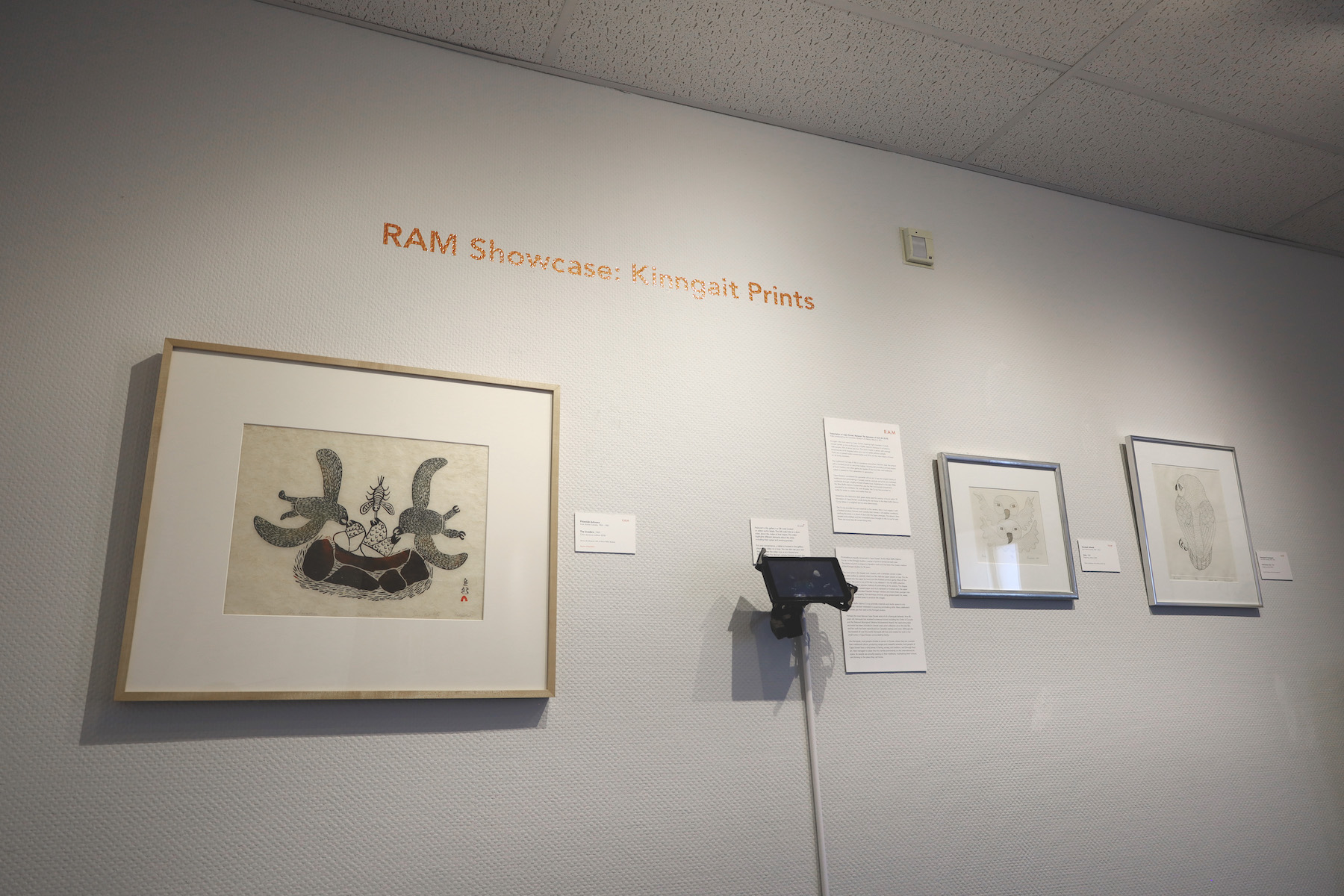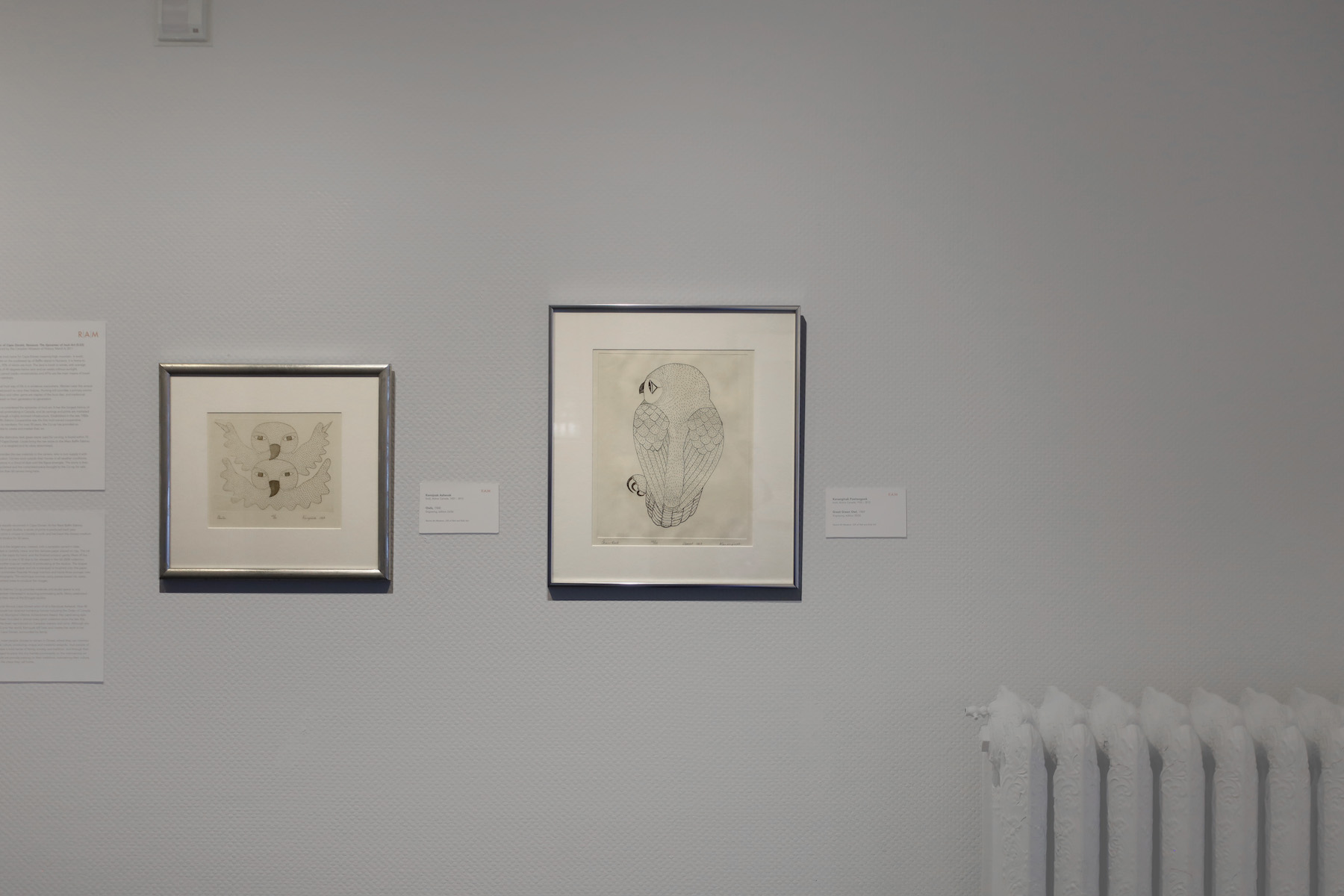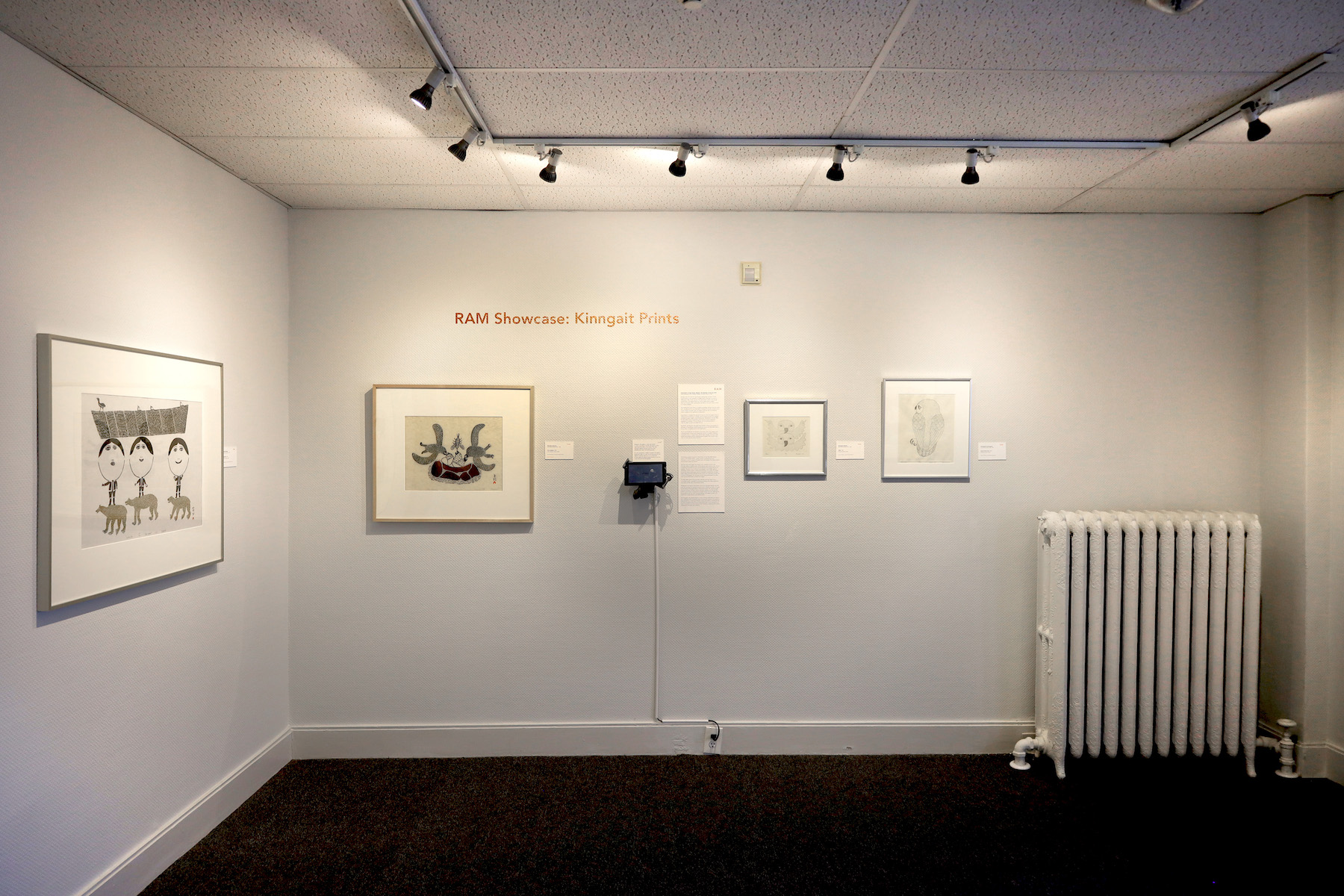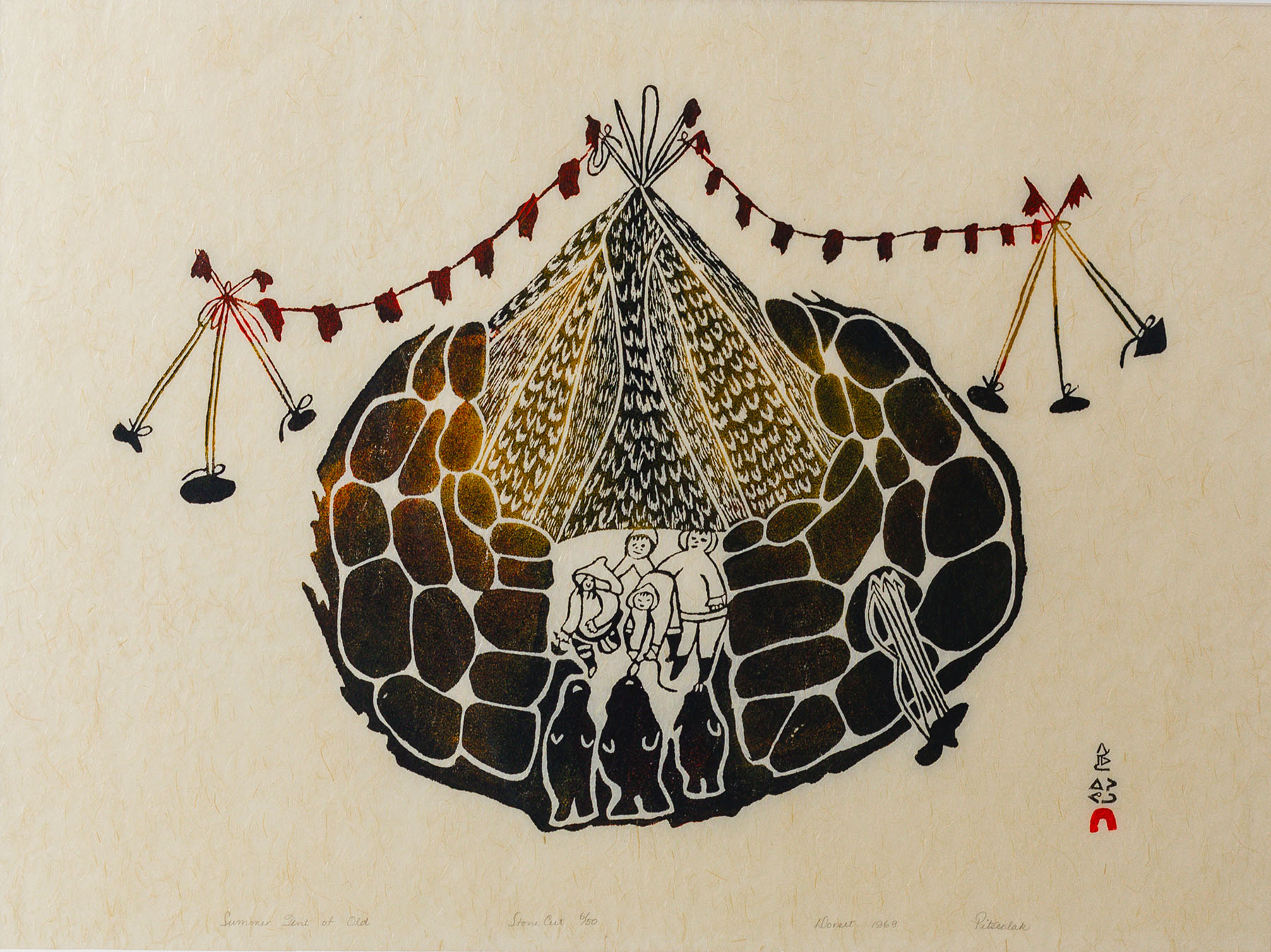
Pitseolak Ashoona
Summer Tent of Old, 1969
Color stone cut, edition 6/50
24 x 36 1/2 inches
Racine Art Museum, Gift of Devra Miller Breslow
Photography: Jarvis Lawson
RAM Showcase: Kinngait Prints
June 12 – August 10, 2024
at RAM’s Wustum Museum
While certain forms of image-making were practiced historically in the region, printmaking was not introduced to Kinngait (formerly known as Cape Dorset) in Arctic Canada until the 1950s. With purchases being made from cooperatives or artists directly, printmaking as a creative practice has become a primary economic stream for multiple generations of Inuit artists over the last few decades.
Most often experimenting with the printing techniques of etching, engraving, lithography, and silkscreen, the Kinngait artists tend to favor subjects and imagery that address the natural world, story-telling, and myths. This direction in subject matter echoes the content of other Kinngait art practices such as carving and drawing. Contemporary Inuit artists expand upon these traditions with work that embraces the past but might also raise critical questions about identity, social and cultural dynamics, and politics.
Home to North America’s largest contemporary craft collection, RAM also has an extensive collection of works on paper that includes fifteen prints from Kinngait artists and a limited edition book featuring works by one of the most prominent printmakers, Kenoujak Ashevak. This exhibition is a sampling of RAM’s current holdings in this area—Kinngait works are being incorporated into other museum programs such as theme exhibitions and social media as well.
The presence of this work in RAM’s collection is invaluable as it reflects an important arena for diverse voices in contemporary printmaking. And it introduces, most likely, new artists into the vocabulary of RAM and Wustum visitors. RAM strives to increase its holdings by contemporary Indigenous makers to showcase these creative visions and help preserve them for future appreciation and consideration.
More About the Exhibition
For Further Research
Kinngait artists’ work gets worldwide audience as studio marks 65 years | Nunatsiaq News
Akunnittinni: A Kinngait Family Portrait | Institute of American Indian Arts
A Family of Artists Creates a Portrait of Inuk Life Across Three Generations | Hyperallergic
Artists in the Exhibition
Kenoujak Ashevak, Pitseolak Ashoona, Etidlooie Kingmeata, Kananginak Pootoogook, and Keeleemeeoomee Samualie
RAM Showcase: Kinngait Prints
June 12 – August 10, 2024
at RAM’s Wustum Museum

Pitseolak Ashoona
Summer Tent of Old, 1969
Color stone cut, edition 6/50
24 x 36 1/2 inches
Racine Art Museum, Gift of Devra Miller Breslow
Photography: Jarvis Lawson
While certain forms of image-making were practiced historically in the region, printmaking was not introduced to Kinngait (formerly known as Cape Dorset) in Arctic Canada until the 1950s. With purchases being made from cooperatives or artists directly, printmaking as a creative practice has become a primary economic stream for multiple generations of Inuit artists over the last few decades.
Most often experimenting with the printing techniques of etching, engraving, lithography, and silkscreen, the Kinngait artists tend to favor subjects and imagery that address the natural world, story-telling, and myths. This direction in subject matter echoes the content of other Kinngait art practices such as carving and drawing. Contemporary Inuit artists expand upon these traditions with work that embraces the past but might also raise critical questions about identity, social and cultural dynamics, and politics.
Home to North America’s largest contemporary craft collection, RAM also has an extensive collection of works on paper that includes fifteen prints from Kinngait artists and a limited edition book featuring works by one of the most prominent printmakers, Kenoujak Ashevak. This exhibition is a sampling of RAM’s current holdings in this area—Kinngait works are being incorporated into other museum programs such as theme exhibitions and social media as well.
The presence of this work in RAM’s collection is invaluable as it reflects an important arena for diverse voices in contemporary printmaking. And it introduces, most likely, new artists into the vocabulary of RAM and Wustum visitors. RAM strives to increase its holdings by contemporary Indigenous makers to showcase these creative visions and help preserve them for future appreciation and consideration.
More About the Exhibition
For Further Research
Kinngait artists’ work gets worldwide audience as studio marks 65 years | Nunatsiaq News
Akunnittinni: A Kinngait Family Portrait | Institute of American Indian Arts
A Family of Artists Creates a Portrait of Inuk Life Across Three Generations | Hyperallergic
Artists in the Exhibition
Kenoujak Ashevak, Pitseolak Ashoona, Etidlooie Kingmeata, Kananginak Pootoogook, and Keeleemeeoomee Samualie
Installation View
Exhibitions at RAM are made possible by:
Platinum Partners
The Estate of Karen Johnson Boyd
David Charak
Judith and David Flegel Fund
Ron and Judith Isaacs

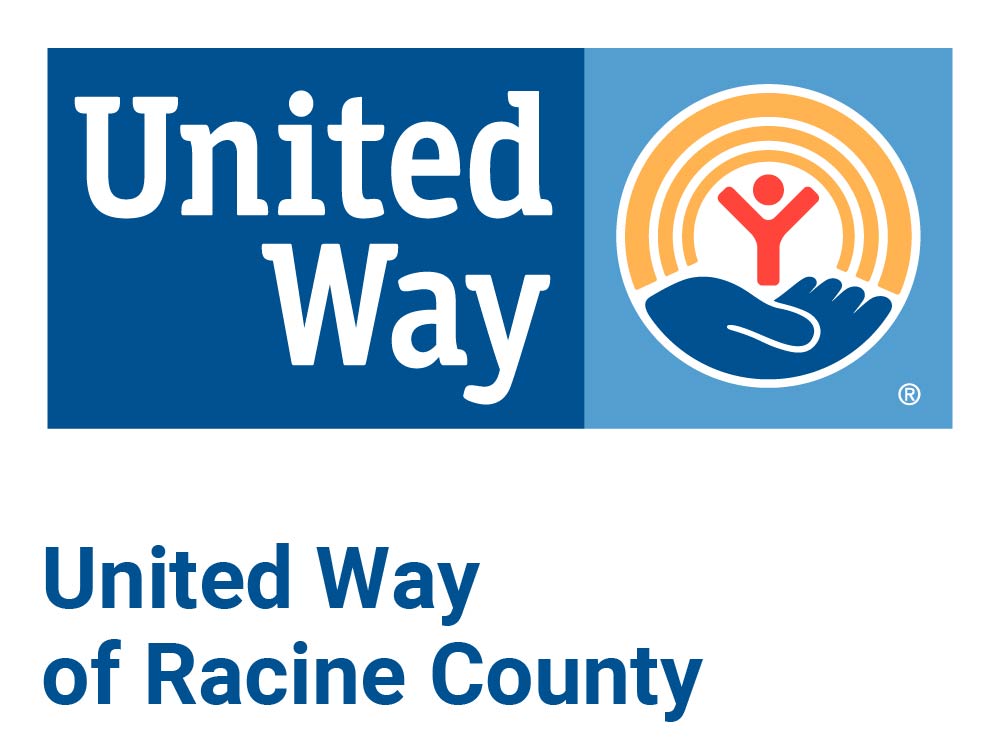
Windgate Foundation
Diamond Partners
Ruffo Family Foundation
Ruth Foundation for the Arts
Diane Zebell
Gold Partners
Anonymous
A.C. Buhler Family
Robert E. Kohler Jr. Fund
Osborne and Scekic Family Foundation
Reliance Controls
Trio Foundation of St. Louis
W.T. Walker Group, Inc.
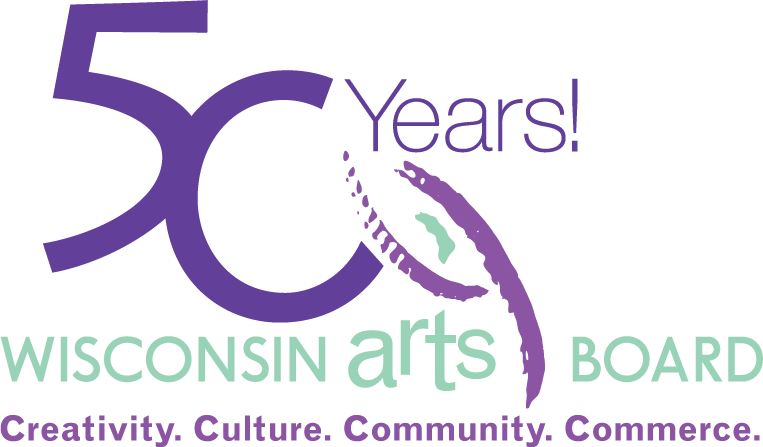
Silver Partners
Anonymous
Sandy and Gus Antonneau
Baird
Lucy G. Feller
Ben and Dawn Flegel
Sharon and Tom Harty
Dave and Judy Hecker
Paula Kalke
Horizon Retail Construction, Inc.
Johnson Financial Group
Lang Family Foundation
Dorothy MacVicar
Jan Serr & John Shannon
Sandra Shove
Willard and Mary Walker
Bronze Partners
Carol Baylon
Rose and Peter Christensen
Dave’s Wine Garage
Educators Credit Union
Patricia and Richard Ehlert
Express Employment Professionals
Deborah Ganaway
Carol Griseto
Hitter’s Baseball
SC Johnson
Bill and Debbie Keland
Nancy and Nick Kurten
Susan Manalli
Norbell Foundation
JoAnna Poehlmann
Rasmussen Diamonds
Harold and Lois Solberg
Kathy Stranghellini
Tito’s
Twin Disc
Janna Waldeck
Barbara Waldman


